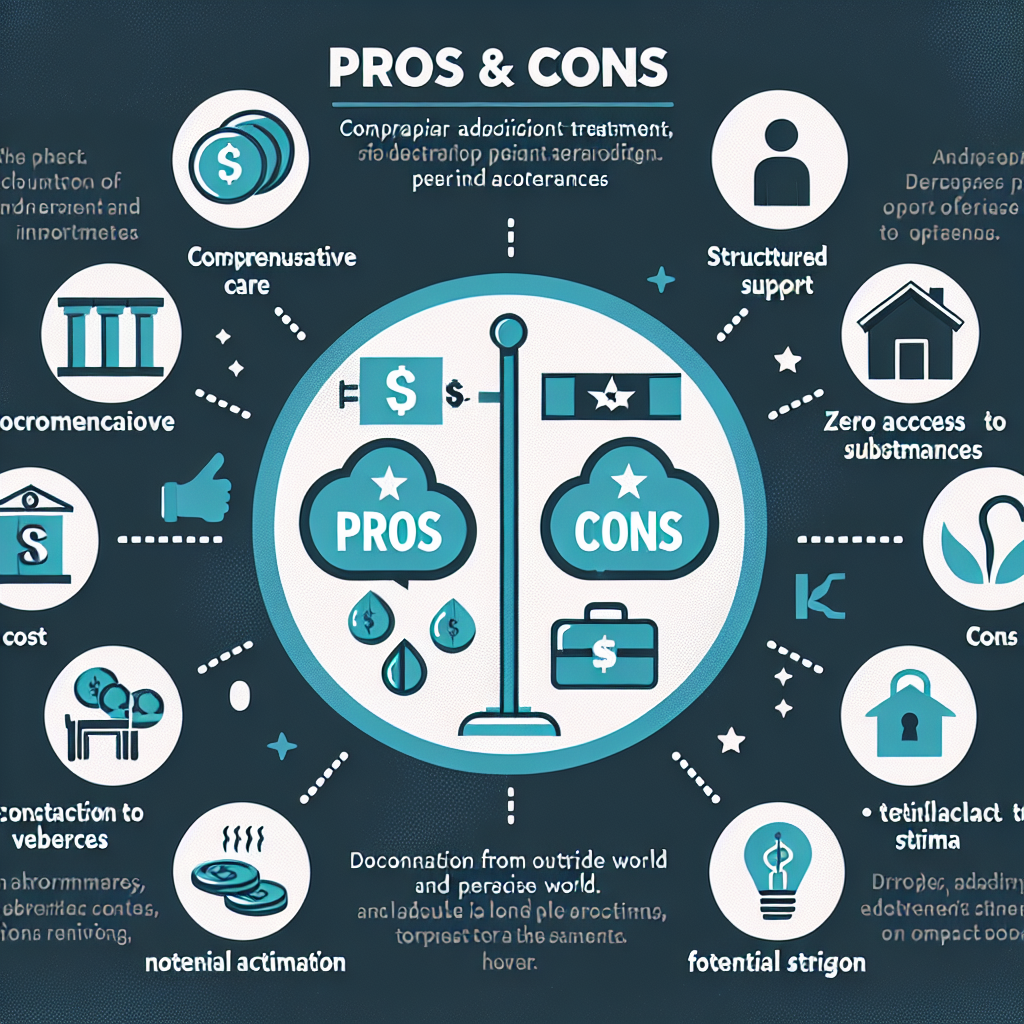-
Table of Contents

“Intensive support and structured environment vs. high cost and time away from daily life.”
Introduction
Inpatient addiction treatment, also known as residential treatment, involves individuals staying at a specialized facility to receive comprehensive care for substance use disorders. This approach offers a structured environment, intensive therapy, and round-the-clock medical supervision, which can be highly beneficial for those struggling with severe addiction. However, it also comes with certain drawbacks, such as high costs and the need for individuals to take time away from their daily lives. Understanding the pros and cons of inpatient addiction treatment is crucial for making an informed decision about the best approach to recovery.
Pros Of Inpatient Addiction Treatment: Comprehensive Care And Structured Environment
Inpatient addiction treatment offers a comprehensive approach to recovery, providing individuals with a structured environment that can significantly enhance their chances of overcoming substance abuse. One of the most notable advantages of inpatient treatment is the comprehensive care it offers. Patients have access to a multidisciplinary team of healthcare professionals, including doctors, therapists, and counselors, who work collaboratively to address the various aspects of addiction. This holistic approach ensures that both the physical and psychological components of addiction are treated, which is crucial for long-term recovery.
Moreover, the structured environment of inpatient treatment facilities plays a pivotal role in the recovery process. These facilities are designed to eliminate distractions and triggers that could lead to relapse. By residing in a controlled setting, patients can focus entirely on their recovery without the stressors and temptations of their everyday lives. This level of immersion allows individuals to develop new, healthier habits and coping mechanisms, which are essential for maintaining sobriety after treatment.
Another significant benefit of inpatient addiction treatment is the sense of community it fosters. Patients are surrounded by others who are going through similar experiences, which can be incredibly comforting and motivating. This shared journey creates a supportive network that encourages individuals to stay committed to their recovery goals. Group therapy sessions and communal activities further strengthen this sense of camaraderie, providing patients with the emotional support they need to persevere through the challenges of recovery.
In addition to emotional support, inpatient treatment facilities often offer a variety of therapeutic modalities that cater to different needs and preferences. From cognitive-behavioral therapy (CBT) to art therapy and mindfulness practices, these diverse treatment options allow patients to explore different avenues for healing. This personalized approach ensures that each individual receives the care that is most effective for them, increasing the likelihood of successful recovery.
However, while the benefits of inpatient addiction treatment are substantial, it is important to acknowledge the potential drawbacks. One of the primary concerns is the cost. Inpatient treatment can be expensive, and not all insurance plans cover the full cost of care. This financial burden can be a significant barrier for many individuals seeking help. Additionally, the time commitment required for inpatient treatment can be challenging. Patients often need to take a leave of absence from work or school, which can disrupt their personal and professional lives.
Another potential downside is the transition back to everyday life after completing inpatient treatment. The controlled environment of the facility provides a safe space for recovery, but re-entering the real world can be daunting. Without the constant support and structure of the treatment center, individuals may struggle to apply the skills and strategies they learned during their stay. This is why aftercare planning and support are crucial components of the recovery process. Many inpatient programs offer follow-up care and resources to help patients navigate this transition and maintain their sobriety.
In conclusion, inpatient addiction treatment offers a comprehensive and structured approach to recovery that can be incredibly beneficial for individuals struggling with substance abuse. The holistic care, supportive community, and diverse therapeutic options create an environment conducive to healing. However, the financial cost, time commitment, and challenges of transitioning back to everyday life are important factors to consider. Despite these potential drawbacks, the transformative impact of inpatient treatment can provide individuals with the tools and support they need to achieve lasting sobriety and reclaim their lives.
Cons Of Inpatient Addiction Treatment: Cost And Disruption To Daily Life
Inpatient addiction treatment, while often highly effective, comes with its own set of challenges that can make it a less appealing option for some individuals. One of the most significant drawbacks is the cost. Inpatient programs are typically more expensive than outpatient alternatives due to the comprehensive nature of the care provided. These programs often include 24-hour medical supervision, therapy sessions, and various forms of support, all of which contribute to the higher price tag. For many, the financial burden can be a substantial barrier to accessing this form of treatment. Insurance may cover some of the costs, but out-of-pocket expenses can still be prohibitive, making it difficult for those without substantial financial resources to afford the care they need.
Another major con of inpatient addiction treatment is the disruption it causes to daily life. Committing to an inpatient program usually means taking a significant amount of time away from work, school, and family responsibilities. This can be particularly challenging for individuals who have dependents or who are the primary breadwinners in their households. The need to step away from daily obligations can create additional stress and anxiety, which may, in turn, impact the effectiveness of the treatment. Moreover, the abrupt change in environment and routine can be jarring, making it difficult for some individuals to adjust to the structured setting of an inpatient facility.
Despite these challenges, it is important to recognize that the temporary disruption and financial investment can lead to long-term benefits. The immersive nature of inpatient treatment allows individuals to focus entirely on their recovery without the distractions and triggers of their everyday environment. This can be particularly beneficial for those with severe addictions or co-occurring mental health disorders, as the comprehensive care provided in an inpatient setting can address multiple aspects of their well-being simultaneously. The structured environment also fosters a sense of community and support, which can be crucial for individuals who feel isolated in their struggle with addiction.
Furthermore, the skills and coping mechanisms learned during inpatient treatment can have a lasting impact, equipping individuals with the tools they need to maintain sobriety once they return to their daily lives. While the initial cost and disruption may seem daunting, the potential for a successful recovery and a healthier future can outweigh these temporary setbacks. It is also worth noting that many inpatient facilities offer financial assistance or sliding scale fees to make treatment more accessible, and exploring these options can help mitigate the financial burden.
In conclusion, while the cost and disruption to daily life are significant cons of inpatient addiction treatment, they should be weighed against the potential benefits. The immersive, supportive environment of an inpatient program can provide the foundation for a successful recovery, offering individuals the opportunity to break free from the cycle of addiction and build a healthier, more fulfilling life. By considering both the challenges and the potential rewards, individuals and their families can make informed decisions about the best path forward in their journey toward recovery.
Q&A
1. **Pros of Inpatient Addiction Treatment:**
– **Structured Environment:** Provides a highly structured environment that minimizes exposure to triggers and distractions, allowing patients to focus solely on recovery.
– **24/7 Medical Support:** Offers continuous medical supervision and support, which is crucial for managing withdrawal symptoms and any potential medical complications.
2. **Cons of Inpatient Addiction Treatment:**
– **Cost:** Generally more expensive than outpatient programs due to the comprehensive care and accommodations provided.
– **Disruption to Daily Life:** Requires patients to take time away from work, family, and other responsibilities, which can be challenging for some individuals.
Conclusion
Inpatient addiction treatment offers several advantages, including a structured environment, 24/7 medical and emotional support, removal from triggers and negative influences, and a comprehensive approach to therapy that includes individual and group counseling. However, it also has drawbacks such as high costs, disruption to personal and professional life, limited privacy, and the potential for difficulty in transitioning back to everyday life after treatment.



